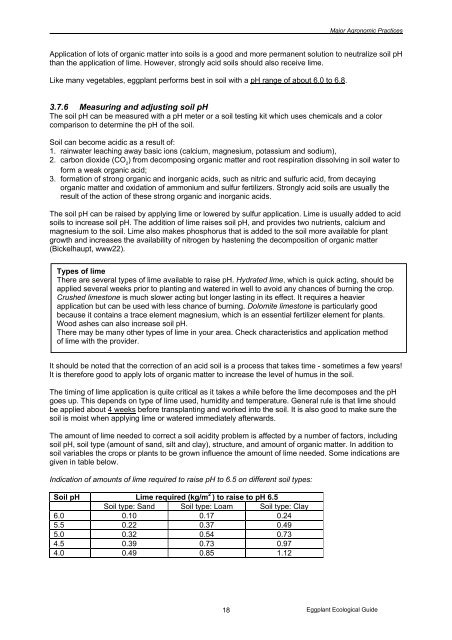Eggplant Integrated Pest Management AN ECOLOGICAL GUIDE
Eggplant Integrated Pest Management AN ECOLOGICAL GUIDE
Eggplant Integrated Pest Management AN ECOLOGICAL GUIDE
Create successful ePaper yourself
Turn your PDF publications into a flip-book with our unique Google optimized e-Paper software.
___________________________________________________________________________________Major Agronomic PracticesApplication of lots of organic matter into soils is a good and more permanent solution to neutralize soil pHthan the application of lime. However, strongly acid soils should also receive lime.Like many vegetables, eggplant performs best in soil with a pH range of about 6.0 to 6.8.3.7.6 Measuring and adjusting soil pHThe soil pH can be measured with a pH meter or a soil testing kit which uses chemicals and a colorcomparison to determine the pH of the soil.Soil can become acidic as a result of:1. rainwater leaching away basic ions (calcium, magnesium, potassium and sodium),2. carbon dioxide (CO 2) from decomposing organic matter and root respiration dissolving in soil water toform a weak organic acid;3. formation of strong organic and inorganic acids, such as nitric and sulfuric acid, from decayingorganic matter and oxidation of ammonium and sulfur fertilizers. Strongly acid soils are usually theresult of the action of these strong organic and inorganic acids.The soil pH can be raised by applying lime or lowered by sulfur application. Lime is usually added to acidsoils to increase soil pH. The addition of lime raises soil pH, and provides two nutrients, calcium andmagnesium to the soil. Lime also makes phosphorus that is added to the soil more available for plantgrowth and increases the availability of nitrogen by hastening the decomposition of organic matter(Bickelhaupt, www22).Types of limeThere are several types of lime available to raise pH. Hydrated lime, which is quick acting, should beapplied several weeks prior to planting and watered in well to avoid any chances of burning the crop.Crushed limestone is much slower acting but longer lasting in its effect. It requires a heavierapplication but can be used with less chance of burning. Dolomite limestone is particularly goodbecause it contains a trace element magnesium, which is an essential fertilizer element for plants.Wood ashes can also increase soil pH.There may be many other types of lime in your area. Check characteristics and application methodof lime with the provider.It should be noted that the correction of an acid soil is a process that takes time - sometimes a few years!It is therefore good to apply lots of organic matter to increase the level of humus in the soil.The timing of lime application is quite critical as it takes a while before the lime decomposes and the pHgoes up. This depends on type of lime used, humidity and temperature. General rule is that lime shouldbe applied about 4 weeks before transplanting and worked into the soil. It is also good to make sure thesoil is moist when applying lime or watered immediately afterwards.The amount of lime needed to correct a soil acidity problem is affected by a number of factors, includingsoil pH, soil type (amount of sand, silt and clay), structure, and amount of organic matter. In addition tosoil variables the crops or plants to be grown influence the amount of lime needed. Some indications aregiven in table below.Indication of amounts of lime required to raise pH to 6.5 on different soil types:Soil pH Lime required (kg/m 2 ) to raise to pH 6.5Soil type: Sand Soil type: Loam Soil type: Clay6.0 0.10 0.17 0.245.5 0.22 0.37 0.495.0 0.32 0.54 0.734.5 0.39 0.73 0.974.0 0.49 0.85 1.1218<strong>Eggplant</strong> Ecological Guide




![Section 4 [ PDF file, 252 KB] - The Field Alliance](https://img.yumpu.com/51387260/1/158x260/section-4-pdf-file-252-kb-the-field-alliance.jpg?quality=85)











